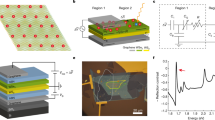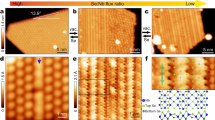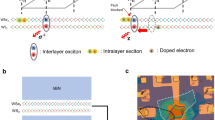Abstract
Stripe phases, in which the rotational symmetry of charge density is spontaneously broken, occur in many strongly correlated systems with competing interactions1,2,3,4,5,6,7,8,9,10,11. However, identifying and studying such stripe phases remains challenging. Here we uncover stripe phases in WSe2/WS2 moiré superlattices by combining optical anisotropy and electronic compressibility measurements. We find strong electronic anisotropy over a large doping range peaked at 1/2 filling of the moiré superlattice. The 1/2 state is incompressible and assigned to an insulating stripe crystal phase. Wide-field imaging reveals domain configurations with a preferential alignment along the high-symmetry axes of the moiré superlattice. Away from 1/2 filling, we observe additional stripe crystals at commensurate filling 1/4, 2/5 and 3/5, and compressible electronic liquid crystal states at incommensurate fillings. Our results demonstrate that two-dimensional semiconductor moiré superlattices are a highly tunable platform from which to study the stripe phases and their interplay with other symmetry breaking ground states.
This is a preview of subscription content, access via your institution
Access options
Access Nature and 54 other Nature Portfolio journals
Get Nature+, our best-value online-access subscription
$29.99 / 30 days
cancel any time
Subscribe to this journal
Receive 12 print issues and online access
$259.00 per year
only $21.58 per issue
Buy this article
- Purchase on Springer Link
- Instant access to full article PDF
Prices may be subject to local taxes which are calculated during checkout




Similar content being viewed by others
Data availability
The data that support the findings of this study are available within the paper and its Supplementary Information. Source data are provided with this paper.
References
Emery, V. J., Kivelson, S. A. & Tranquada, J. M. Stripe phases in high-temperature superconductors. Proc. Natl Acad. Sci. USA 96, 8814–8817 (1999).
Lee, P. A., Nagaosa, N. & Wen, X. G. Doping a Mott insulator: physics of high-temperature superconductivity. Rev. Mod. Phys. 78, 17–85 (2006).
Keimer, B., Kivelson, S. A., Norman, M. R., Uchida, S. & Zaanen, J. From quantum matter to high-temperature superconductivity in copper oxides. Nature 518, 179–186 (2015).
Stewart, G. R. Superconductivity in iron compounds. Rev. Mod. Phys. 83, 1589–1652 (2011).
Koulakov, A. A., Fogler, M. M. & Shklovskii, B. I. Charge density wave in two-dimensional electron liquid in weak magnetic field. Phys. Rev. Lett. 76, 499–502 (1996).
Du, R. R. et al. Strongly anisotropic transport in higher two-dimensional Landau levels. Solid State Commun. 109, 389–394 (1999).
Lilly, M. P., Cooper, K. B., Eisenstein, J. P., Pfeiffer, L. N. & West, K. W. Evidence for an anisotropic state of two-dimensional electrons in high Landau levels. Phys. Rev. Lett. 82, 394–397 (1999).
Li, J. R. et al. A stripe phase with supersolid properties in spin-orbit-coupled Bose-Einstein condensates. Nature 543, 91–94 (2017).
Cao, Y. et al. Nematicity and competing orders in superconducting magic-angle graphene. Preprint at https://arxiv.org/abs/2004.04148 (2020).
Kerelsky, A. et al. Maximized electron interactions at the magic angle in twisted bilayer graphene. Nature 572, 95–100 (2019).
Jiang, Y. H. et al. Charge order and broken rotational symmetry in magic-angle twisted bilayer graphene. Nature 573, 91–95 (2019).
Serlin, M. et al. Intrinsic quantized anomalous Hall effect in a moire heterostructure. Science 367, 900–903 (2020).
Sharpe, A. L. et al. Emergent ferromagnetism near three-quarters filling in twisted bilayer graphene. Science 365, 605–608 (2019).
Cao, Y. et al. Correlated insulator behaviour at half-filling in magic-angle graphene superlattices. Nature 556, 80–84 (2018).
Cao, Y. et al. Unconventional superconductivity in magic-angle graphene superlattices. Nature 556, 43–50 (2018).
Chen, G. R. et al. Signatures of tunable superconductivity in a trilayer graphene moire superlattice. Nature 572, 215–219 (2019).
Zhang, Z. M. et al. Flat bands in twisted bilayer transition metal dichalcogenides. Nat. Phys. 16, 1093–1096 (2020).
Regan, E. C. et al. Mott and generalized Wigner crystal states in WSe2/WS2 moire superlattices. Nature 579, 359–363 (2020).
Tang, Y. H. et al. Simulation of Hubbard model physics in WSe2/WS2 moire superlattices. Nature 579, 353–358 (2020).
Wu, F. C., Lovorn, T., Tutuc, E. & MacDonald, A. H. Hubbard model physics in transition metal dichalcogenide moire bands. Phys. Rev. Lett. 121, 026402 (2018).
Wang, L. et al. Correlated electronic phases in twisted bilayer transition metal dichalcogenides. Nat. Mater. 19, 861–866 (2020).
Wu, F. C. & Das Sarma, S. Collective excitations of quantum anomalous Hall ferromagnets in twisted bilayer graphene. Phys. Rev. Lett. 124, 046403 (2020).
Shimazaki, Y. et al. Strongly correlated electrons and hybrid excitons in a moire heterostructure. Nature 580, 472–477 (2020).
Jin, C. H. et al. Observation of moire excitons in WSe2/WS2 heterostructure superlattices. Nature 567, 76–80 (2019).
Zhang, Y., Yuan, N. F. Q. & Fu, L. Moire quantum chemistry: charge transfer in transition metal dichalcogenide superlattices. Phys. Rev. B. 102, 201115 (2020).
Xu, Y. et al. Correlated insulating states at fractional fillings of moire superlattices. Nature 587, 214–218 (2020).
Jin, C. et al. Imaging and control of critical fluctuations in two-dimensional magnets. Nat. Mater. 19, 1290–1294 (2020).
Fernandes, R. M. & Venderbos, J. W. F. Nematicity with a twist: rotational symmetry breaking in a moiré superlattice. Sci. Adv. 6, eaba8834 (2020).
Tasaki, H. The Hubbard model—an introduction and selected rigorous results. J. Phys.-Condens Mat. 10, 4353–4378 (1998).
Kivelson, S. A., Fradkin, E. & Emery, V. J. Electronic liquid-crystal phases of a doped Mott insulator. Nature 393, 550–553 (1998).
Wang, L. et al. One-dimensional electrical contact to a two-dimensional material. Science 342, 614–617 (2013).
Pan, H. N., Wu, F. C. & Das Sarma, S. Quantum phase diagram of a Moiré–Hubbard model. Phys. Rev. B. 102, 201104 (2020).
Ashoori, R. C. et al. Single-electron capacitance spectroscopy of discrete quantum levels. Phys. Rev. Lett. 68, 3088–3091 (1992).
Zibrov, A. A. et al. Tunable interacting composite fermion phases in a half-filled bilayer-graphene Landau level. Nature 549, 360–364 (2017).
Shi, Q. H. et al. Odd- and even-denominator fractional quantum Hall states in monolayer WSe2. Nat. Nanotechnol. 15, 569–573 (2020).
Kaburagi, M. & Kanamori, J. Ground-state structure of triangular lattice gas model with up to 3rd-neighbor interactions. J. Phys. Soc. Jpn. 44, 718–727 (1978).
Coppersmith, S. N., Fisher, D. S., Halperin, B. I., Lee, P. A. & Brinkman, W. F. Dislocations and the commensurate-incommensurate transition in two dimensions. Phys. Rev. Lett. 46, 549–552 (1981).
Bak, P., Mukamel, D., Villain, J. & Wentowska, K. Commensurate-incommensurate transitions in rare-gas monolayers adsorbed on graphite and in layered charge-density-wave systems. Phys. Rev. B. 19, 1610–1613 (1979).
Mahmoudian, S., Rademaker, L., Ralko, A., Fratini, S. & Dobrosavljevic, V. Glassy dynamics in geometrically frustrated Coulomb liquids without disorder. Phys. Rev. Lett. 115, 025701 (2015).
Acknowledgements
We thank E.-A. Kim for fruitful discussions. This work was supported by the US Department of Energy, Office of Science, Basic Energy Sciences, under award number DE-SC0019481 (growth of WSe2 crystals and optical characterization), the US Army Research Office under grant number W911NF-17-1-0605 (device fabrication), the US Office of Naval Research under award number N00014-18-1-2368 (capacitance measurements) and the Air Force Office of Scientific Research under award number FA9550-20-1-0219 (optical microscopy). The growth of hBN crystals was supported by the Elemental Strategy Initiative of MEXT, Japan and CREST (grant no. JPMJCR15F3). L.F. acknowledges support from the Simons Investigator Award from the Simons Foundation. K.F.M. acknowledges support from the David and Lucille Packard Fellowship. C.J. acknowledges support from the Kavli Postdoctoral Fellowship. Z.T. acknowledges support from the Watt W. Webb Graduate Fellowship in Nanoscience.
Author information
Authors and Affiliations
Contributions
C.J. and Z.T. performed the optical experiments and analysis. T.L. and J.Z. performed the capacitance experiment and analysis. L.F. performed theoretical analysis. T.L., Z.T., Y.X., Y.T. and J.Z. fabricated the devices. S.L. and J.C.H. grew the bulk TMD crystals. K.W. and T.T. grew the bulk hBN crystals. C.J., J.S. and K.F.M. designed the scientific objectives and oversaw the project. C.J., J.S. and K.F.M. cowrote the manuscript. All authors discussed the results and commented on the manuscript.
Corresponding authors
Ethics declarations
Competing interests
The authors declare no competing interests.
Additional information
Peer review information Nature Materials thanks the anonymous reviewers for their contribution to the peer review of this work.
Publisher’s note Springer Nature remains neutral with regard to jurisdictional claims in published maps and institutional affiliations.
Supplementary information
Supplementary Information
Supplementary Notes 1–9 and Figs. 1–11.
Source data
Source Data Fig. 1
Source data for penetration capacitance and PL in Fig. 1d.
Source Data Fig. 2
Source data for Fig. 2 with each panel given as a different tab.
Source Data Fig. 3
Source data for Fig. 3 with each panel given as a different tab.
Source Data Fig. 4
Source data for Fig. 4a,b,c,e with each panel given as a different tab.
Rights and permissions
About this article
Cite this article
Jin, C., Tao, Z., Li, T. et al. Stripe phases in WSe2/WS2 moiré superlattices. Nat. Mater. 20, 940–944 (2021). https://doi.org/10.1038/s41563-021-00959-8
Received:
Accepted:
Published:
Issue Date:
DOI: https://doi.org/10.1038/s41563-021-00959-8
This article is cited by
-
Mapping charge excitations in generalized Wigner crystals
Nature Nanotechnology (2024)
-
Excitonic Mott insulator in a Bose-Fermi-Hubbard system of moiré WS2/WSe2 heterobilayer
Nature Communications (2024)
-
Remote imprinting of moiré lattices
Nature Materials (2024)
-
Optical readout of the chemical potential of two-dimensional electrons
Nature Photonics (2024)
-
Valley-polarized excitonic Mott insulator in WS2/WSe2 moiré superlattice
Nature Physics (2024)



